Angular Pipe 是一個很強大的資料顯示轉型的工具,可以透過 Pipe 的幫忙,將原始資料轉換成我們想要顯示的樣式,且不會異動到原始資料的內容。
Angular 有內建了一些 Pipe 像是 DatePipe、 UpperCasePipe、LowerCasePipe、 CurrencyPipe 和 PercentPipe及其他的 Pipe。當然 Angular 也允許讓我們自訂 Pipe 的功能。
先從內建的 Pipe 介紹起
內建 Pipe
在詳細介紹內建 Pipe 之前,有一點要注意的是,如果有使用到 DatePipe 和 CurrencyPipe 時,要在舊版瀏覽器上正常運作的話,需要額外再加上一個 polyfill 的 library
1 | <script src="https://cdn.polyfill.io/v2/polyfill.min.js?features=Intl.~locale.en"></script> |
DatePipe
功能
將日期根據當地的顯示規則顯示
使用方式
date_expression | date[:format]
說明
-
date_expression必須是日期型別的物件或是數字(milliseconds) 或是 ISO 文字 -
format可以用來調整要顯示的日期格式,可以使用的格式說明如下'short': 相當於'yMdjm'(例如9/3/2010, 12:05 PMforen-US)'medium': 相當於'yMMMdjms'(例如Sep 3, 2010, 12:05:08 PMforen-US)long: 相當於MMMM d, y, h:mm:ss a z(例如June 15, 2015 at 9:03:01 AM GMT+1)'full': 相當於'EEEE, MMMM d, y, h:mm:ss a zzzz'(例如Monday, June 15, 2015 at 9:03:01 AM GMT+01:00)'fullDate': 相當於'yMMMMEEEEd'(例如Friday, September 3, 2010foren-US)'shortDate': 相當於'yMd'(例如9/3/2010foren-US)'longDate': 相當於'yMMMMd'(例如September 3, 2010foren-US)'mediumDate': 相當於'yMMMd'(例如Sep 3, 2010foren-US)'fullDate': 相當於'EEEE, MMMM d, y'(例如Monday, June 15, 2015)'shortTime': 相當於'jm'(例如12:05 PMforen-US)'mediumTime': 相當於jms'(例如12:05:08 PMforen-US)'longTime': 相當於'h:mm:ss a z'(例如9:03:01 AM GMT+1)'fullTime': 相當於'h:mm:ss a zzzz'(例如9:03:01 AM GMT+01:00)
描述 符號 短表示 長表示 數值 2 位數 ear G GGG(AD) GGGG
(Anno Domini)year y y(2015) yy(15) month M MMM(Sep) MMMM
(September)M(9) MM(09) day d d(3) dd(03) weekday E EEE(Sun) EEEE
(Sunday)hour j j(13) jj(13) hour12 h h(1 PM) hh(01 PM) hour24 H h(13) HH(13) minute m m(5) mm(05) second s s(9) ss(09) timezone z z
(Pacific Standard Time)timezone Z Z(GMT-8:00) timezone a a(PM)
範例
1 | import { Component } from '@angular/core'; |
顯示結果
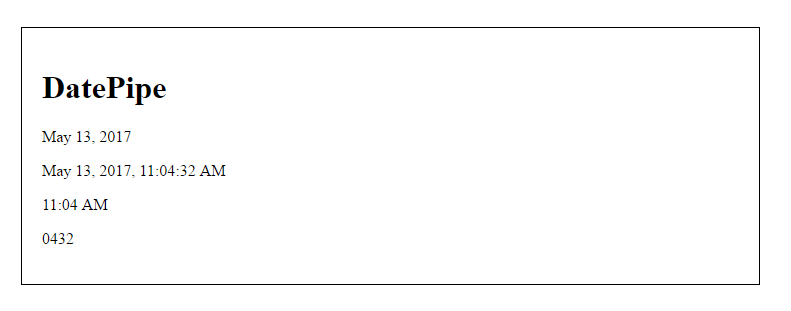
UpperCasePipe
功能
將所有英文字轉換成大寫
使用方式
string_expression | uppercase
範例
1 | import { Component } from '@angular/core'; |
顯示結果

LowerCasePipe
功能
將所有英文字轉換成小寫
使用方式
string_expression | lowercase
範例
1 | import { Component } from '@angular/core'; |
顯示結果

TitleCasePipe
功能
將每一個英文單字的第一個字母變成大寫
使用方式
string_expression | titlecase
範例
1 | import { Component } from '@angular/core'; |
顯示結果

CurrencyPipe
功能
將數字根據當地貨幣的顯示規則顯示
使用方式
number_expression | currency[:currencyCode[:symbolDisplay[:digitInfo]]]
說明
- 只接收數字型別的資料
currencyCode是 ISO 4217 貨幣代碼,例如USD代表美金,TWD代表新台幣。symbolDisplay是布林值,用來決定是否顯示貨幣符號或是貨幣代碼true使用符號 (例如$).false(預設): 使用貨幣代碼 (e.g.USD).
digitInfo請參閱DecimalPipe的說明.
範例
1 | import { Component } from '@angular/core'; |
顯示結果
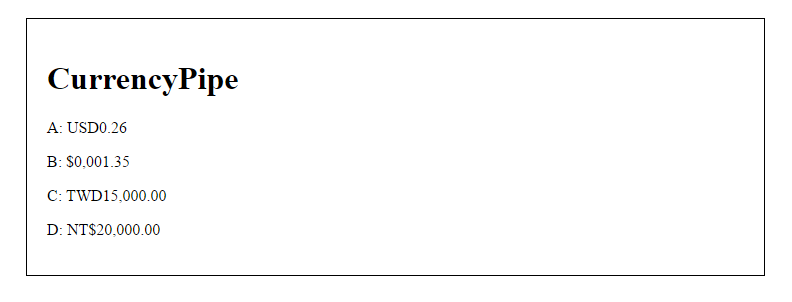
PercentPipe
功能
將數字根據當地顯示規則顯示百分比
使用方式
number_expression | percent[:digitInfo]
說明
- 只接收數字型別的資料
digitInfo請參閱DecimalPipe的說明.
範例
1 | import { Component } from '@angular/core'; |
顯示結果

DecimalPipe
功能
將數字根據當地顯示規則顯示
使用方式
number_expression | number[:digitInfo]
說明
-
只接收數字型別的資料
-
digitInfo以文字形式來設定數字顯示規則1
{minIntegerDigits}.{minFractionDigits}-{maxFractionDigits}
minIntegerDigits是整數最小顯示位數,預設為1.minFractionDigits是小數點後最小顯示位數,預設為0.maxFractionDigits是小數點後最大顯示位數,預設為3
範例
1 | import { Component } from '@angular/core'; |
顯示結果
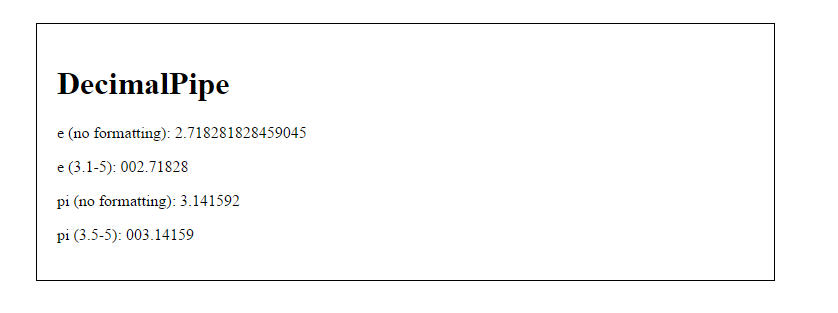
JsonPipe
功能
將值轉換成 JSON 文字
使用方式
expression | json
說明
- 使用
JSON.stringify的方法將值轉換成文字
範例
1 | import { Component } from '@angular/core'; |
顯示結果
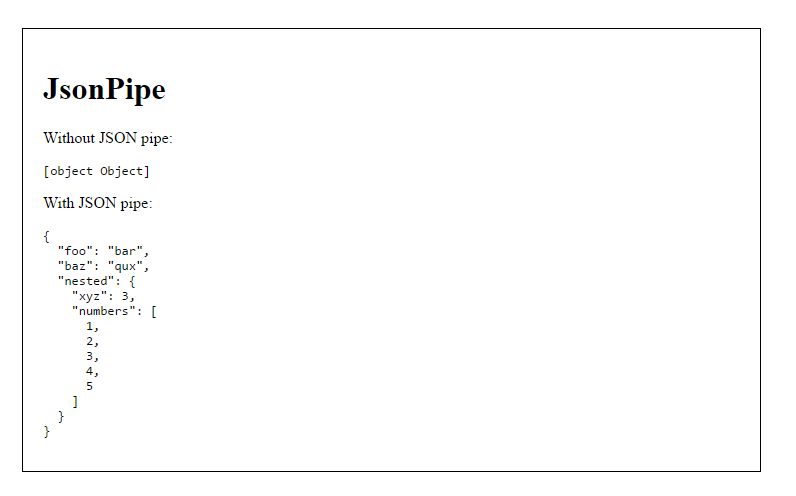
SlicePipe
功能
建立新的清單或是切割後的部分文字
使用方式
array_or_string_expression | slice:start[:end]
說明
- 只接收陣列或是文字型的資料
start是切割的開始位置- 如果是
正整數則會回傳該位置以後的資料或文字。 - 如果是
負整數則會從資料或文字結尾往回計算開始位置,在回傳該位置之後的資料或文字。 - 如果是
正整數而且該整數大於陣列或是文字長度時,則會回傳空的陣列或文字。 - 如果是
負整數而且該整數大於陣列或是文字長度時,則會回傳整個陣列或文字。
- 如果是
end是切割的結束位置- 如果是沒有給予任何數字時,則回傳到結尾的所有資料。
- 如果是
正整數則回傳結束位置前的所有資料或文字。 - 如果是
負整數則會從資料或文字結尾往回計算結束位置,並回傳結束位置前的所有資料或文字。
- 所有的行為都是基於
Array.prototype.slice()和String.prototype.slice()的基礎上。 - 如果操作的對象是一個陣列,每次都會回傳一個全新的陣列
- 如果操作的資料是空值,Pipe 會回傳空值
範例
1 | import { Component } from '@angular/core'; |
顯示結果
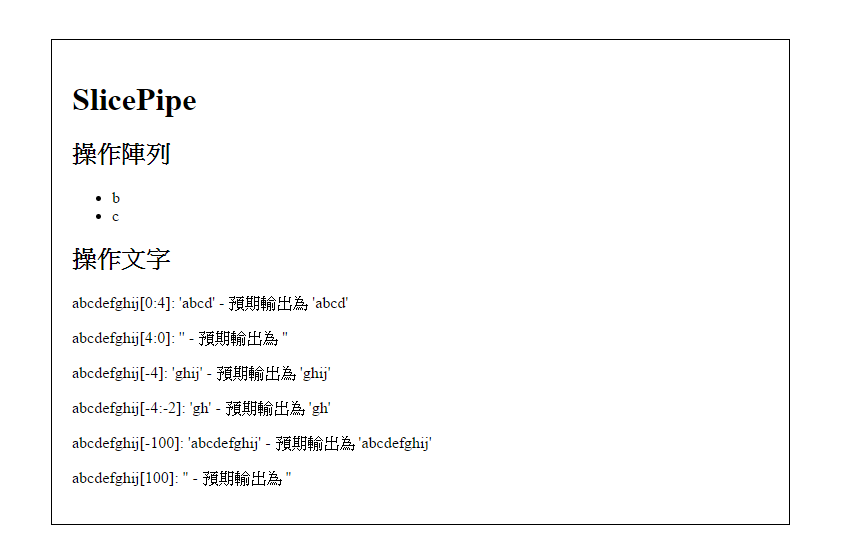
AsyncPipe
功能
從非同步動作 (Promise/Observable) 中取出資料
使用方式
observable_or_promise_expression | async
說明
async pipe 會訂閱一個 Observable 或是 Promise 物件,並獲取最後發生的資料。當有新的資料產生時,async pipe 會提示 ChangeDetector 要檢查 Component 的值。
當 Comoponent 被摧毀時,通常是離開該 Component的時候,async 會自動取消訂閱 ( unsubscribe),避免潛在的記憶體洩漏問題。
範例
1 | import { Component } from '@angular/core'; |
顯示結果

I18nPluralPipe & I18nSelectPipe
由於這兩個 Pipe 跟多國語系功能有關係,且皆處於 Experimental 階段,故在次先不做說明。
自訂 Pipe
透過 CLI 產生 Pipe 是最快的,指令是
```typescript ng g p 「pipeName」
1 |
|
transformfunction 所回傳的值,會用來顯示在畫面上- 第一個參數
value是所要轉換的資料來源 - 第二個之後的參數可以用來接 Template 傳給
pipe的參數值
如果要傳入多個參數的時後,transform 的地方值直接加上第 3 的參數或是使用 …args 也是可以,而在 template 的使用方式則是 {{ value | xxpipe: 1_arg: 2_arg: 3:arg }} 以此類推。
Pipe 與 ChangeDetection
Angular 會透過 change detection 方法執行的過程中,去檢查 data-bound 值的變化,而 change detection 會在每一次 DOM Eevent 後被觸發,例如按下鍵盤的鍵,滑鼠的移動,伺服器的回應等事件,這個過程是需要付出相對的成本,為了效能,Angular 會盡量降低 change detection 的次數
所以 Pipe 會採用最簡單又快速的判斷規則,ChangeDetectionStrategy.OnPush。
這表示當 Pipe 如果用在陣列上,就有機會出現不在預期內的顯示結果,如以下的範例
1 | import { Pipe, PipeTransform } from '@angular/core'; |
component
1 | ({ |
Pure and Impure Pipes
Angular 的 Pipe 預設皆為 Pure,如果需要設定為 Impure的話,請這樣子設定
1 | ({ |
至於什麼是 Pure Pipe ,什麼是 Impure Pipe
Pure Pipe
這裡所指的 Pure,至針對 Pipe 所要轉換的值是否為 Pure Change,所謂的 Pure Change 是改變 primitive input value( String, Number, Boolean, Symbol) 或是改變 Object 參考的位址 (Date, Array, Function, Object)。
這規則與 ChangeDetectionStrategy.OnPush 是一樣的。在上面的例子中,因為 heroes 是一個陣列物件,如果是 push的行為並不會改變該陣列所參考的位址 (ByReference),必須重新建立一個新的陣列物件,才會改變參考位址。
Impure Pipe
Impure Pipe 就是 Pure的相反,也是 ChangeDetectionStrategy 預設的執行方式,只要有資料異動,就會觸發改變。
來調整一下上面的範例,來讓 array.push 也可以做到畫面更新顯示的功能。
1 | import { Pipe, PipeTransform } from '@angular/core'; |
當這樣子設定為 Impure時,下面的 push 就可以使用而且畫面也會更新
1 |
|